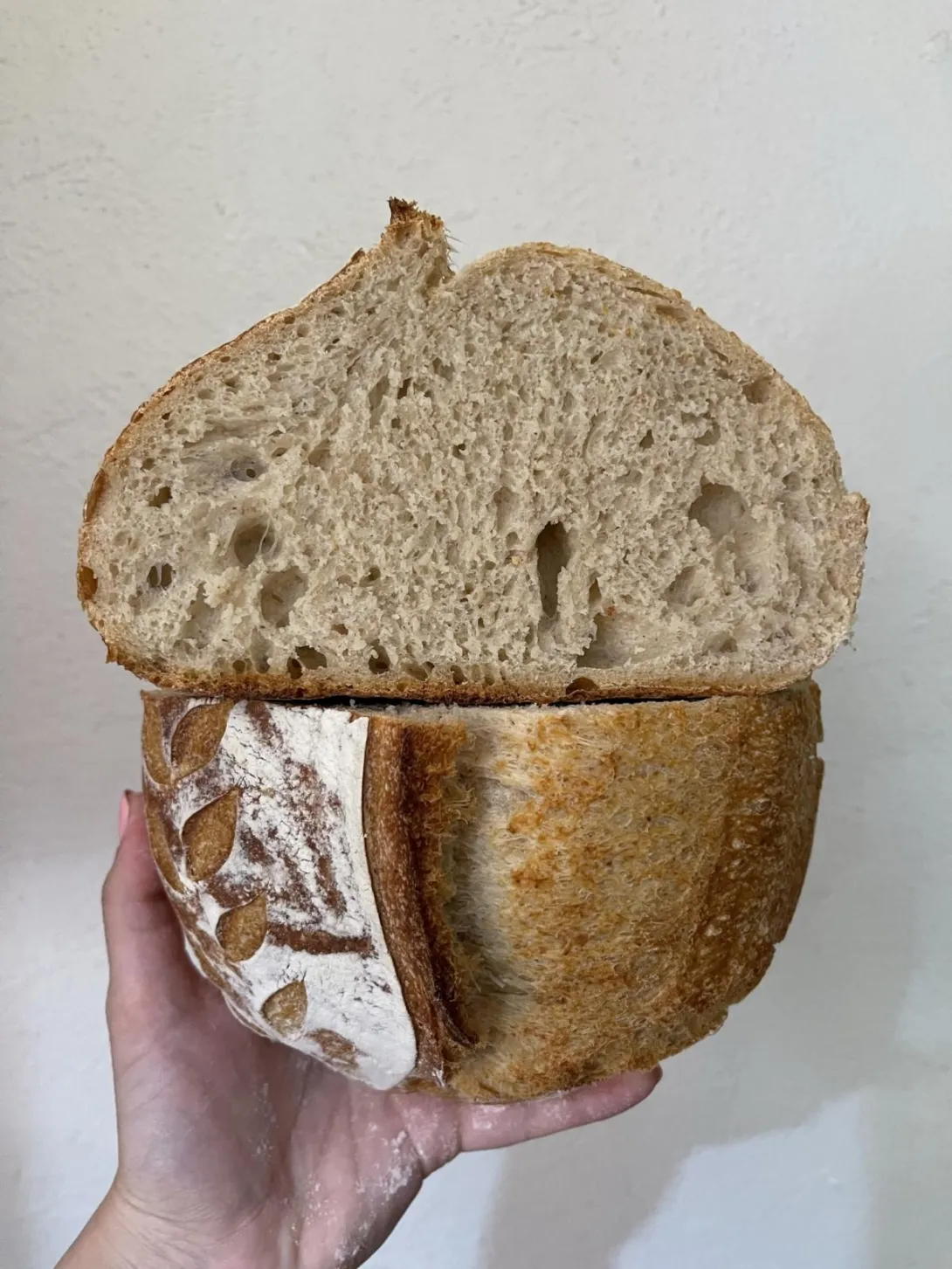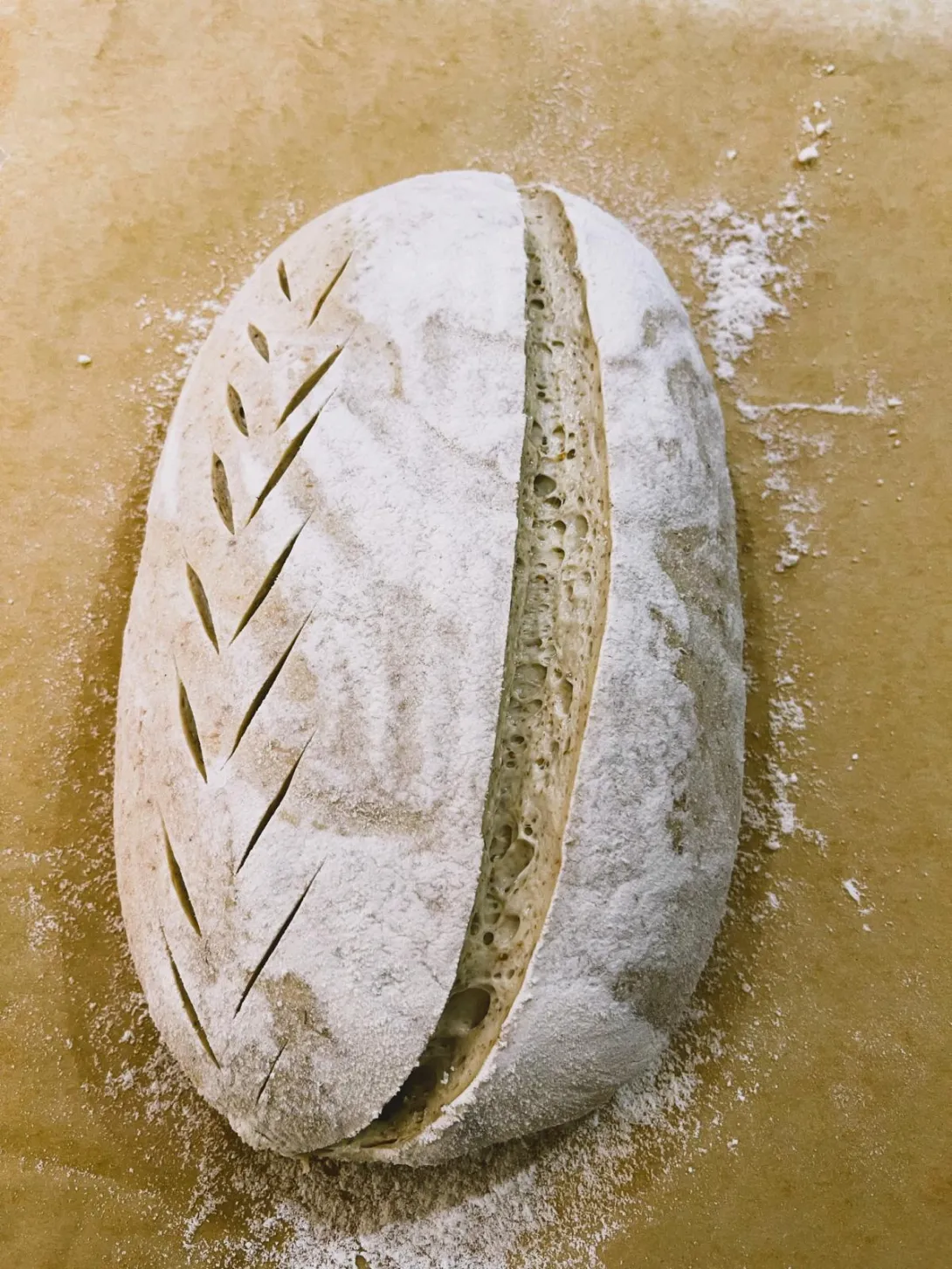Hi there,
I am a beginer sourdough baker in need of help :)
I am struggling to get that nice airy crumb on my bread. The texture I get is a bit of an uneven, small and slight moist crumb as (hopefully!) you can tell by the fotos. There’s a nice oven spring and I am happy with how the baked loaves look, but the issue is only with the crumb :(
I am attaching a foto of the scoring after the cold retard as well, since I see lots of bubbles just before it goes in the oven.. but they don’t hold up the heat I guess..
My recipe:
90% strong white bread flour
10% wheat flour
15% starter

Mix everything together starting with water and starter, add flour and salt and I let it autolyze for 45min.
Then I do 4 strech and folds between 30 min intervals.
Allow it to bulk rise for an extra of 2-3 hours after last strech and fold
Preshape and bench rest for 15 min
Final shape and room temp proofing for 1 hour to get it going
Cold retard for aprox. 12 hours
Score and bake

I just wanted to say that the loaf is beautiful. I love how the scoring opened up. Sorry, I have no advice to offer being a beginner...
I'm curious, what temperature and baking technique are you using?
Thank you!!
I am baking it in a gas oven, the temp is a bit tricky to figure out cause it’s a very old one but I usually go with the max it can give which is aprox. 500 celsius.
I bake it for 20-25 min in a dutch oven with the lid on, and another 20-25 without the lid.
I’m not sure why your crumb isn’t more open, although the bread doesn’t look dense at all. BUT, I do see something interesting. Take a look at the uncooked and scored dough. Notice how nice and open the cell structure looks. Maybe the dough was over proofed. Benny is pretty good at crumb diagnostics. I’ll ask him to take a look.
Temperature during fermentation is as important as any other ingredient or aspect of bread baking. Try to include ambient temps when describing your bake. When we consider any bake, flour (whole grain and/or commercial flour), percentage of levain or commercial yeast, and ambient temperature are some of the major things we looks for. If the exact temp is unknown an estimate is still very helpful. Take a look at the link below.
https://www.thefreshloaf.com/node/69904/tip-time-temperature-are-important-any-ingredient
Thank you so much for the feedback!! The ambient temp for my kitchen is around 18celsius/ 65 fahrenheit and this is where I always ferment my dough, hope this helps.
The fermentation looks really good as indicated by the photo of the scored dough. I wonder where you live? How high is the protein in your bread flour? Based on your description of the flour not being able to take 75% hydration I’d guess that your bread flour isn’t that strong, as stronger bread flour should be able to take 75% hydration. Given that information I would consider doing a couple of things, one would be reducing the hydration just a tiny bit to 68% or so, this would make the gluten stronger with less mechanical mixing. The other would be to do some kneading after the autolyse to more fully develop the gluten up front so that those beautiful fermentation gases can be contained by the gluten in your dough. You could do some slap and folds say 100-200 to get more strength up front before your folds.
By the way, filling out your profile can be very helpful when asking for help as if we know where you’re located we’d have a better idea of the types of flours available to you.
Benny
Thank you Benito! I live in Mexico, the flour I use has 14gr of protein and between 350-450w strength. It’s the best I could find out here :(
I’ll give it a go with the slap and folds like you suggested and see if that makes a difference and I’ll update the profile as well for future posts, thx for the tip!
Mada
Your flour sounds like it is super strong.
That is a very strong flour Mada, see what happens when you add some early gluten development.
Everyone has different methods, but to me it looks like you have a lot of fermentation before shaping, then a quick hour before cold retard. Maybe extend your stretch and folds (as well as start with some slap and fold earlier). E.g shorten your autolyse to 25 mins and do 2ir 3 slap and folds at 10 min intervals. Then do 4 stretch and folds at 40 min intervals. Rather than let it sit before shaping, try shaping at that point, and leave the extra time in the Benetton as a shaped loaf - an hour or two at room temp before the retard. And then when you bake, maybe check the loaf with a poke test - for me at those times I’d be likely to need an hour or two warming up before ready to bake.
overall I reckon if spring is good but it’s dense - generally sign of under proofing. (But the scored loaf looks perfect, so that’s just a guess). One last thing. I’d be reluctant to go with less water. The size of the bubbles is a simple gas pressure/temp/volume thing but is proportional to how soft or hard the dough is. Way too soft and it won’t hold shape, but too hard and you are trying to blow up bubbles in tractor tyre rubber…
ive seen it suggested that spring/bubble size is due to a last minute explosion of yeast working - but that’s wrong IMO - curves of growth v temp shows a peak around 30c I think. And loaves proofing even at 30 don’t rise like a baking loaf! So oven spring is pretty much entirely the blowing up of the existing gas bubbles with heat - until the crust sets and locks it up.
Good luck
Wow, awesome feedback thank you! I did another test yesterday and I think the issue is indeed with the proofing time :( I am having trouble doing the poke test when it gets out of the fridge so I will probably need to play around with the times until I get just right.. Like you say probably leave it out for an hour or two after the cold retard and then do a poke test.
When I first started I thought the bulk rise was what was causing all my problems but now I find the proofing time being my biggest challenge yet haha
I wouldn’t give this up for anything though, baking sourdough is the best :)
Thanks everyone for all your help!!
No worries. Just concerned my ‘banneton’ came out as ‘Benetton’! Must have been some spellcheck thing!’
Mada, I didn’t take the time to reread all of the replies so hopefully I am not repeating something that was already stated.
Many of the bakers on The Fresh Loaf use the following method with great success.
This method produces outstanding results…
Danny